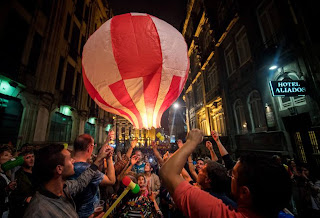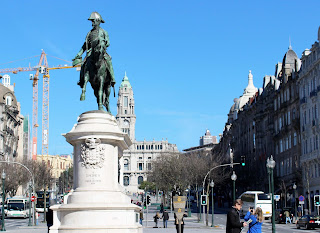São João in Porto
São João in Porto - Saint John
São João, or Saint John, is one of the most celebrated saints in Europe, and the main celebration of Porto.
Most of the people celebrate São João by staying the whole night of 23rd to the 24th of June in the streets, eating and drinking, dancing, and following ancient traditions related to this day: the release of hot balloons, the greetings with plastic hammers, the sale of plants like leek and basil all around the city and the baths in Douro river.
Origin of São João in Porto:In June there is a very well-known phenomenon, the summer solstice, that marks the passing of Spring to Summer and it is also the shortest night of the year.
The summers solstice on the 21st of June has always been a very important date in the agricultural world, by being related to fertilization and abundance. It was, in the early times, very common to celebrate them with pagan traditions, here in Porto.
Naturally, these pagan celebrations became catholic and the 24th of June is now related to São João (Saint John).
Naturally, these pagan celebrations became catholic and the 24th of June is now related to São João (Saint John).
Traditions in Porto:
But, analyzing the São João celebration you can identify that most of the traditions are still pagan, even if the population doesn't remember. We are talking about the millenary cults to Fire, Water, and Fertility.
The hot air balloons are a perfect representation of Fire, and this practice is related to the Cult of the Sun God.
The hot air balloons are a perfect representation of Fire, and this practice is related to the Cult of the Sun God.
The baths in the Douro River or in the Atlantic clearly represent Water and having those showers will guarantee a year without ill-fortune.
The Fertility is represented in the morning dew that is considered the god’s saliva, and it was largely believed that a sterile woman who rolled in the morning dew of Saint John's day would be able to conceive.
The Fertility is represented in the morning dew that is considered the god’s saliva, and it was largely believed that a sterile woman who rolled in the morning dew of Saint John's day would be able to conceive.
While some of the São João's traditions got lost with the course of time (the first documentation about these celebrations is from the 14th century), some remained until today, and we even had some new additions recently.
Some of the traditions that were lost are:
- Harvesting rosemary to produce an amulet-bouquet;
- Water mint tea harvested by a virgin girl in the evening of São João that would protect against ill-spells;
- Mugwort plant to protect against hexes;
- Girls that had more than one love would roll pieces of paper with the names of the loved ones in a bowl of water during São João’s evening and with the first rays of sunshine the most open piece of paper would have the name of her future husband.
The traditions that still remain until today, even if people might have forgotten their meaning are:
- The leek that we playfully shove it into people's faces in the streets would be stored behind the house's door during the whole year to work as a talisman;
- The hot air balloons, that are released with a wish;
- The baths in the river or the ocean;
- The sanjoaninas (from São João) cascades, that have their origin in the Christmas Cribs and usually tell the tales of Porto. Always including the popular saints and emblematic areas of the city;
- The raids - Rusgas - that represent the rivalry between different neighborhoods of Porto.
- The basil flower, it’s customary in couples to give the gift of a basil flower to the significant other, like a marriage proposal. The gifted one has to tend for the basil flower until the next year where it will be replaced by a new one. For being such a gentle and tender flower it has to be taken care of with a lot of care and that would represent the compromise. Also, it’s from the general knowledge that the plant dies if you smell it directly with your nose. So it’s told that you should smell it using your hand.
 |
| Alho Porro - Leek - São João in Porto |
Plastic Hammers:
The most well-known tradition, and that the one that stands out, is the plastic hammer.
These hammers are used to greet people, and by greet, we mean hitting each other with the hammers on the head.
The hammers were not initially created for the São João but for the academic celebrations that happen in May, in the 1960s.
They were created by a plastics factory - "Plásticos Estrela" - and the idea was to make a toy that would make screeching noises for the students that were finishing their studies. The students loved it so much that they brought them to the São João celebrations in the following month. It ended having so much success that they were incorporated in the celebrations of São João until today.
 |
| Plastic Hammers - São João in Porto |
Gastronomy:
On a partying night, and by night we mean since the sunset until dawn, we obviously need food!
In the longest night of Porto, the grilled sardines are the queens between the food. The whole city smells of grilled sardines - and we love it!
 |
| Grilled sardines - São João in Porto |
Little is known that initially, they were not part of it, they were added recently.
The traditional food would be: "Cabrito Assado" - roasted lamb, "Caldo Verde" - green broth and "Farturas" - a funneled shape fried fair-like sweet.
The traditional food would be: "Cabrito Assado" - roasted lamb, "Caldo Verde" - green broth and "Farturas" - a funneled shape fried fair-like sweet.
Nowadays you can find food not only in the food tents throughout the city but also at the doorsteps since local people grill sardines and pork and sell it to the ones passing down the street.
 |
| Caldo Verde - São João in Porto |
São João these days:
We are not talking about the known and loved Fado but the "Pimba'', which has a style more folklore/pop, and the lyrics are filled with sexual innuendos or simplistic romantic sentimentalism. Our favorite singer is Quim Barreiros.
If you are planning a short and fast visit to Porto in June, the 23rd - São João’s night - is a perfect choice!
In the morning you can do a quick tour of the city center, at least to know where you will be spending the night. There are some very nice Free Tours in Porto with City Lovers Tours to help you to get to know the city.
A good place to start is the Aliados Avenue, where you will be able to see the marches and the raids. In the afternoon you can go to the areas of biggest celebration: Fontainhas neighborhood, Guindais neighborhood, Ribeira, Praça da Alegria, which are the areas where you will find the true Tripeiros and join them for a beer (Fino), Sardines (Sardinhas) or pork sandwich (Bifanas).
Some tips to survive:
If you are planning a short and fast visit to Porto in June, the 23rd - São João’s night - is a perfect choice!
In the morning you can do a quick tour of the city center, at least to know where you will be spending the night. There are some very nice Free Tours in Porto with City Lovers Tours to help you to get to know the city.
A good place to start is the Aliados Avenue, where you will be able to see the marches and the raids. In the afternoon you can go to the areas of biggest celebration: Fontainhas neighborhood, Guindais neighborhood, Ribeira, Praça da Alegria, which are the areas where you will find the true Tripeiros and join them for a beer (Fino), Sardines (Sardinhas) or pork sandwich (Bifanas).
Some tips to survive:
Um Fino, por favor means "a draught beer please".
 |
| Um fino - beer - São João in Porto |
Uma Bifana, por favor means "a pork sandwich please".




Comments
Post a Comment